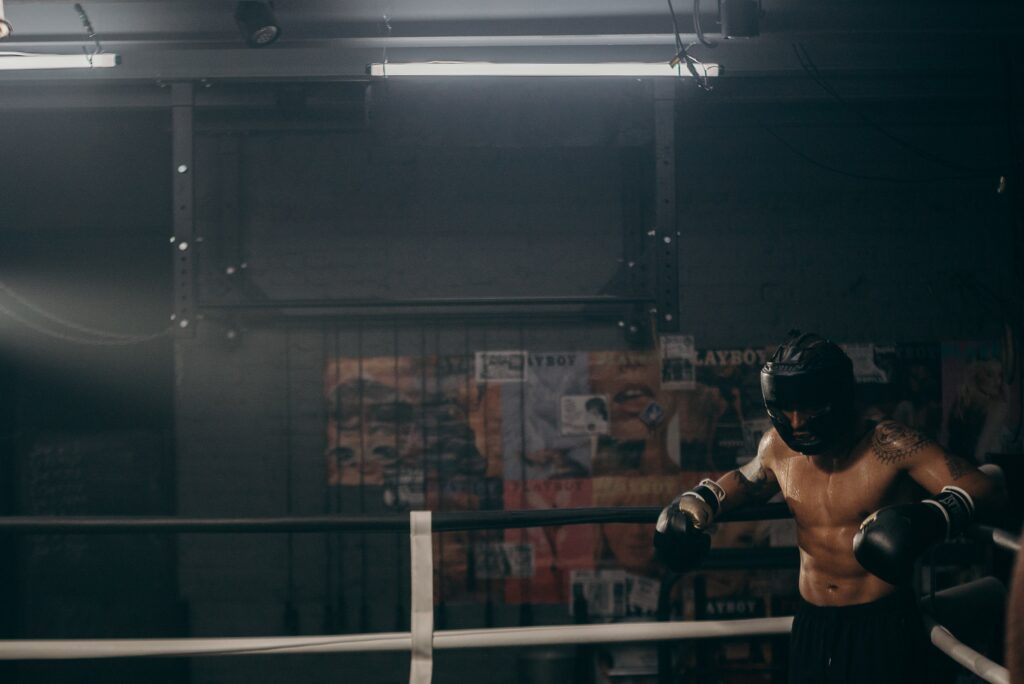Are you inspired by the chiseled physiques of professional boxers? Do you dream of having a body like theirs? Well, you don’t have to be a professional boxer to achieve a similar physique. With the right approach, anyone can get a boxer’s body.
In this article, we will explore tips on how to achieve a boxer’s body.

We’ll cover the importance of a balanced diet, the significance of cardiovascular and strength training, and other essential factors that contribute to a toned and muscular body like a boxer’s.
If you’re serious about getting a boxer’s body, this article is for you.
Our tips are not just based on theories; we’ve consulted with fitness experts and professional boxers to bring you proven advice that works.
So, without further ado, let’s dive in and discover the secrets of how to get a boxer’s body.
Dial-in on your nutrition
To achieve a boxer’s body, focusing on your nutrition is crucial. Here are some tips to help you dial-in on your nutrition:
- Eat a balanced diet: Make sure your meals include a variety of nutrient-dense foods such as lean protein, complex carbohydrates, healthy fats, and vegetables.
- Stay hydrated: Drinking plenty of water is essential for proper bodily function, and it can also help you feel fuller, which may prevent overeating.
- Control portion sizes: To maintain a healthy weight, it’s important to monitor how much you eat. You can use measuring cups, a food scale, or your hand to estimate portion sizes.
- Eat frequently: Eating smaller, more frequent meals throughout the day can help keep your metabolism revved up and prevent overeating at mealtime.
- Limit processed foods: Processed foods are often high in calories, unhealthy fats, and added sugars, which can make it difficult to achieve a lean physique. Stick to whole, unprocessed foods as much as possible.
By following these tips, you can help your body get the nutrition it needs to build a boxer’s physique.
Remember, consistency is key, so be patient and stay committed to your nutrition plan.
You need to be eating the right foods
If you want to achieve a boxer’s body, eating the right foods is crucial. Here are some tips to help you get the nutrients you need:
- Lean protein: Boxers need plenty of protein to build and repair muscle tissue. Lean sources such as chicken breast, fish, turkey, and lean cuts of beef can help you meet your protein needs.
- Complex carbohydrates: Carbohydrates provide the energy your body needs for training and recovery. Choose complex carbohydrates such as sweet potatoes, quinoa, brown rice, and whole-grain bread to keep you fueled.
- Healthy fats: Healthy fats like those found in nuts, avocado, and olive oil are essential for hormone production and maintaining overall health.
- Vegetables: Vegetables are packed with essential vitamins and minerals that can help support your body’s functions. Aim to eat a variety of colorful vegetables each day to ensure you’re getting a wide range of nutrients.
- Hydration: Staying hydrated is important for maintaining proper bodily function, especially during workouts. Drink plenty of water and consider electrolyte-replenishing drinks if you’re training for long periods or in hot conditions.
By incorporating these foods into your diet, you can help your body build the strength and endurance needed to achieve a boxer’s physique. Don’t forget to eat in moderation and to listen to your body’s hunger and fullness cues.
You need to train like a boxer to look like a boxer
If you want to look like a boxer, you need to train like one. Here are some tips to help you train like a boxer:
-
Cardio
If you want to look like a boxer, you need to train like one. Cardiovascular training is an essential part of a boxer’s routine. Here are some tips to help you improve your cardio:
- Running: Running is a great way to improve your cardiovascular endurance. Try to incorporate some distance running into your training, as well as shorter sprints to improve your speed.
- Jumping rope: Jumping rope is a classic exercise that boxers use to improve their footwork, coordination, and endurance. Start with short intervals and gradually work your way up to longer sessions.
- Interval training: Interval training involves alternating periods of high-intensity exercise with periods of lower-intensity exercise or rest. This type of training can help improve your endurance and burn more calories in less time.
- Swimming: Swimming is a low-impact form of cardio that can be great for people with joint issues. It can also help improve your lung capacity and overall endurance.
By incorporating these cardio exercises into your training routine, you can improve your cardiovascular endurance and start to develop a boxer’s physique.
Remember to start slowly and gradually increase your intensity and duration to avoid injury.
-
Weights and bodyweight training
In addition to cardiovascular training, weights and bodyweight training are also essential for developing a boxer’s physique. Here are some tips to help you incorporate weights and bodyweight training into your routine:

- Resistance training: Boxers use resistance training to build strength and power in their muscles. Exercises like squats, deadlifts, bench press, and pull-ups are great for building overall strength.
- Plyometrics: Plyometrics involves explosive movements that can help improve your speed and power. Exercises like box jumps, jump squats, and medicine ball throws can be great for improving your explosive power.
- Bodyweight exercises: Bodyweight exercises like push-ups, pull-ups, lunges, and planks can help you develop functional strength, improve your balance, and prevent injury.
- Core training: Boxers need a strong core to support their movements and improve their balance. Exercises like sit-ups, Russian twists, and leg raises can help you develop a strong core.
By incorporating these types of exercises into your training routine, you can build the strength and power necessary to develop a boxer’s physique.
Remember to vary your routine and challenge yourself with increasing weight or reps to keep seeing progress.
-
Abs
Developing strong abs is an important part of achieving a boxer’s physique. Here are some tips to help you train your abs like a boxer:
- Core exercises: Core exercises like planks, sit-ups, and leg raises can help you develop a strong core, which is essential for maintaining good posture and balance.
- Oblique exercises: Boxers use their obliques to rotate their torso and generate power in their punches. Exercises like Russian twists and side planks can help you develop strong oblique muscles.
- High-intensity interval training (HIIT): HIIT is a type of cardio exercise that involves short bursts of high-intensity exercise followed by periods of rest. HIIT can help you burn fat and reveal your abs.
- Boxing-specific ab exercises: There are also some boxing-specific ab exercises that can help you develop functional strength for punching and moving in the ring. Examples include medicine ball twists, medicine ball slams, and standing cable rotations.
By incorporating these exercises into your training routine, you can develop strong and functional abs that will help you achieve a boxer’s physique.
However, it’s important to remember that diet and overall body fat percentage also play a role in revealing your abs, so make sure to maintain a healthy diet and overall fitness routine.
-
Recovery
Recovery is an important part of any training routine, including boxing. Here are some tips to help you recover like a boxer:
- Rest days: Boxers typically train hard but also incorporate rest days into their routine. This allows the body to recover and prevent injury. Make sure to take at least one or two rest days per week.
- Foam rolling: Foam rolling can help release tension in your muscles and improve circulation. This can help reduce soreness and improve recovery time.
- Stretching: Stretching can help improve flexibility and range of motion, which can help prevent injury and improve recovery time.
- Proper nutrition: Nutrition is also essential for recovery. Make sure to fuel your body with the nutrients it needs to repair and rebuild muscles. This includes protein for muscle repair and carbohydrates for energy.
- Sleep: Sleep is important for overall health and recovery. Aim for at least 7-8 hours of sleep per night to allow your body to rest and recover.
By incorporating these recovery tips into your training routine, you can improve your overall health and fitness and reduce the risk of injury.
Remember to listen to your body and adjust your routine as needed to prevent overtraining.
-
Training Programs
If you want to train like a boxer and achieve a boxer’s physique, there are many training programs available to help you achieve your goals. Here are some examples:
- Boxing classes: Many gyms and fitness studios offer boxing classes that incorporate boxing-specific training, such as shadowboxing, bag work, and sparring.
- High-intensity interval training (HIIT): HIIT workouts can help you burn fat and build endurance, which are both important for achieving a boxer’s physique.
- Strength training: Incorporating strength training into your routine can help you build muscle and improve your overall strength and power.
- Cross-training: Cross-training with other types of workouts, such as running, cycling, or swimming, can help improve your overall fitness and prevent overuse injuries.
- Personal training: Hiring a personal trainer who specializes in boxing or sports-specific training can help you create a customized program to achieve your goals.
No matter which training program you choose, it’s important to be consistent and dedicated to your workouts in order to see results.
Remember to also maintain a healthy diet and focus on recovery to support your training efforts.
What Are the Hallmarks of the Boxer Physique?
The Obvious
The boxer physique is easily recognizable due to its characteristic features, which include a lean and muscular build with low body fat.
One of the most notable features is the presence of defined abs, which are a result of the high level of core strength and low body fat that comes with boxing training.
In addition, boxers tend to have well-developed shoulders and back muscles due to the upper body movements involved in the sport. While boxers do have well-defined muscles in their arms and legs, their overall build is usually lean and not overly bulky.
This is because boxing requires a high level of cardiovascular fitness, which is reflected in a boxer’s good overall fitness and endurance.

The boxer physique is also characterized by a balanced distribution of muscle mass throughout the body, with no one muscle group dominating over the others.
Overall, achieving a boxer’s physique requires a combination of high-intensity training, proper nutrition, and a focus on overall fitness and conditioning.
The Hidden
Apart from the obvious physical features that characterize a boxer’s physique, there are also some hidden traits that contribute to their overall appearance and athletic ability.
Here are some of the hidden hallmarks of the boxer physique:
- Speed and agility: Boxers are known for their lightning-fast movements and quick reflexes, which are a result of their high level of speed and agility training.
- Balance and coordination: Boxing requires a high level of balance and coordination, which is developed through footwork drills and coordination exercises.
- Mental toughness: To succeed in boxing, one must have a strong mindset and the ability to stay focused and determined even in the face of adversity.
- Reaction time: Boxers have excellent reaction time, which allows them to respond quickly to their opponent’s movements and throw effective punches.
- Endurance: Boxing is a physically demanding sport that requires a high level of endurance, both in terms of cardiovascular fitness and muscular endurance.
These hidden hallmarks of the boxer physique are just as important as the obvious physical features when it comes to achieving success in the sport.
To develop a boxer’s physique, it’s important to focus on all aspects of training, including speed and agility, balance and coordination, mental toughness, reaction time, and endurance.
Now let see 9 training tips for boxers who want to looks like a boxer.
8 Training Tips for a Boxer Body
1. Get Lean
The first tip for achieving a boxer’s body is to get lean. Boxers have a low body fat percentage, which allows their muscles to be more defined and visible.
To achieve a lean body, it’s important to focus on nutrition and create a calorie deficit by burning more calories than you consume. This can be achieved through a combination of cardio exercise and weight training.
Cardio exercise is essential for burning calories and reducing body fat. Activities such as running, cycling, and jumping rope are effective ways to increase your heart rate and burn calories.
In addition to cardio, weight training can help build muscle and boost metabolism, which can lead to more efficient fat burning.
It’s also important to pay attention to nutrition and eat a healthy, balanced diet with plenty of lean protein, vegetables, and complex carbohydrates. This can help fuel your workouts and keep your body in a calorie deficit.
It’s important to note that getting lean takes time and consistency.
It’s not a quick fix or a one-time effort. It requires a sustained effort over time, with a focus on maintaining a healthy lifestyle that includes regular exercise and proper nutrition.
2. Train Your Arms
The second tip for achieving a boxer’s body is to train your arms. Boxers are known for their powerful punches, which are a result of strong arm muscles.
To train your arms like a boxer, it’s important to focus on exercises that target the biceps, triceps, and shoulders.
Some effective arm exercises include bicep curls, tricep dips, shoulder presses, and push-ups. These exercises can be done with weights, resistance bands, or bodyweight, depending on your preference and fitness level.
It’s important to gradually increase the weight or resistance to challenge your muscles and promote growth.
Boxers also incorporate specific training drills to improve their punching power and speed. This includes shadowboxing, heavy bag work, and sparring.
These drills not only improve arm strength but also improve overall boxing technique and conditioning.
When training your arms, it’s important to remember to balance your workouts with exercises that target other muscle groups, such as the core and legs. This can help create a well-rounded physique and improve overall performance in the sport.
3. Develop Your Core
The third tip for achieving a boxer’s body is to develop your core muscles. A strong core is essential for generating power in punches and maintaining balance and stability in boxing movements.
To develop your core, it’s important to incorporate exercises that target the abs, obliques, and lower back muscles. Some effective core exercises include planks, Russian twists, bicycle crunches, and back extensions.
It’s important to focus on proper form and avoid straining the lower back.
Boxers also incorporate specific training drills to improve their core strength and stability. This includes medicine ball exercises, twisting movements, and balance training.
These drills not only improve core strength but also improve overall boxing technique and conditioning.
When training your core, it’s important to remember to balance your workouts with exercises that target other muscle groups, such as the arms and legs.
This can help create a well-rounded physique and improve overall performance in the sport.
4. Do Some Leg Work
The fourth tip for achieving a boxer’s body is to do some leg work. Strong legs are essential for generating power in punches and maintaining balance and stability in boxing movements.
To work your legs like a boxer, it’s important to incorporate exercises that target the quadriceps, hamstrings, calves, and glutes. Some effective leg exercises include squats, lunges, deadlifts, and calf raises.
These exercises can be done with weights, resistance bands, or bodyweight, depending on your preference and fitness level. It’s important to gradually increase the weight or resistance to challenge your muscles and promote growth.
Boxers also incorporate specific training drills to improve their leg strength and explosiveness.
This includes footwork drills, agility training, and plyometrics. These drills not only improve leg strength but also improve overall boxing technique and conditioning.
When training your legs, it’s important to remember to balance your workouts with exercises that target other muscle groups, such as the arms and core. This can help create a well-rounded physique and improve overall performance in the sport.
5. Aim for the V Shape
The fifth tip for achieving a boxer’s body is to aim for the “V shape”. The V shape refers to the broad shoulders and narrow waistline that is commonly associated with boxers.
To achieve the V shape, it’s important to focus on exercises that target the shoulders and back muscles. Some effective exercises include pull-ups, lat pulldowns, rows, and shoulder presses.
These exercises can be done with weights, resistance bands, or bodyweight, depending on your preference and fitness level. It’s important to gradually increase the weight or resistance to challenge your muscles and promote growth.
In addition to strength training, it’s also important to incorporate cardiovascular exercise to burn fat and reveal the muscle definition.
High-intensity interval training (HIIT) and steady-state cardio, such as running or cycling, can be effective for burning calories and promoting fat loss.
When aiming for the V shape, it’s important to remember to balance your workouts with exercises that target other muscle groups, such as the arms, core, and legs. This can help create a well-rounded physique and improve overall performance in the sport.
6. Do Lots of Cardio
The sixth tip for achieving a boxer’s body is to do lots of cardio. Cardiovascular exercise is crucial for building endurance and improving overall conditioning, both of which are essential for boxing.
There are many types of cardio exercises that can be effective for boxers, including running, cycling, swimming, and jump rope.
High-intensity interval training (HIIT) is also a popular form of cardio that involves short bursts of intense exercise followed by periods of rest or lower-intensity exercise.

Boxers often incorporate specific cardio drills into their training, such as shadowboxing, sparring, and heavy bag work. These drills not only improve cardiovascular fitness but also improve technique and timing.
When incorporating cardio into your training, it’s important to start slowly and gradually increase the intensity and duration over time. It’s also important to vary your cardio routine to prevent boredom and to challenge your body in different ways.
In addition to cardio, it’s important to also incorporate strength training and proper nutrition into your training regimen to achieve a well-rounded and effective workout routine.
7. Build Muscular Endurance, Especially in the Shoulders
The seventh tip for achieving a boxer’s body is to build muscular endurance, especially in the shoulders.
Boxers rely heavily on their shoulder muscles for punching, blocking, and defending, so it’s important to develop strong and enduring shoulder muscles.
One effective way to build shoulder endurance is to incorporate high-rep sets into your weightlifting routine.
This means performing multiple sets of an exercise with a lighter weight boxing gloves and a higher number of repetitions. This type of training helps to build muscular endurance and promote muscular fatigue.
In addition to weightlifting, it’s important to incorporate specific shoulder exercises into your training regimen, such as dumbbell or barbell shoulder presses, lateral raises, and front raises. These exercises target the various muscles of the shoulders and help to develop strength and endurance.
Boxers also frequently use resistance bands to train their shoulders, as they provide a different type of resistance than traditional weights and can help to improve range of motion and flexibility.
Incorporating exercises that specifically target the shoulders and building endurance through high-rep sets can help to develop the strong and enduring shoulder muscles that are necessary for boxing.
8. Use Pilates for Recovery
The eighth tip for achieving a boxer’s body is to use Pilates for recovery. Pilates is a form of exercise that focuses on strengthening the core muscles, improving posture, and increasing flexibility.
It can also be a great way to aid in recovery after a tough boxing workout.
Pilates exercises can help to increase blood flow to the muscles, which can aid in recovery and reduce muscle soreness. The focus on core strength and stability can also help to prevent injuries and improve overall performance.
One effective Pilates exercise for boxers is the plank. This exercise targets the core muscles and can help to improve stability and balance, which are important for boxing.
Other Pilates exercises that can be beneficial for boxers include the Pilates roll-up, Pilates teasers, and Pilates push-ups.
In addition to using Pilates exercises for recovery, boxers should also incorporate other recovery techniques into their training regimen, such as stretching, foam rolling, and massage.
These techniques can help to reduce muscle soreness and improve flexibility, allowing boxers to perform at their best during training and competition.
Here if you want to know what is hybrid boxing glove.
Conclusion:
In conclusion, achieving a boxer’s body requires a combination of consistent exercise, proper nutrition, and a strong mindset.
By following the tips outlined in this blog, you can start your journey towards building a lean and toned physique that will not only make you look great but also improve your overall health and fitness.
Remember to focus on high-intensity workouts, incorporate strength training exercises, and fuel your body with nutrient-dense foods.
Don’t forget to prioritize rest and recovery to allow your muscles to repair and grow stronger.
So, are you ready to start your transformation journey? What other tips do you have for achieving a boxer’s body?
Share your thoughts in the comments below and let’s continue the conversation.






